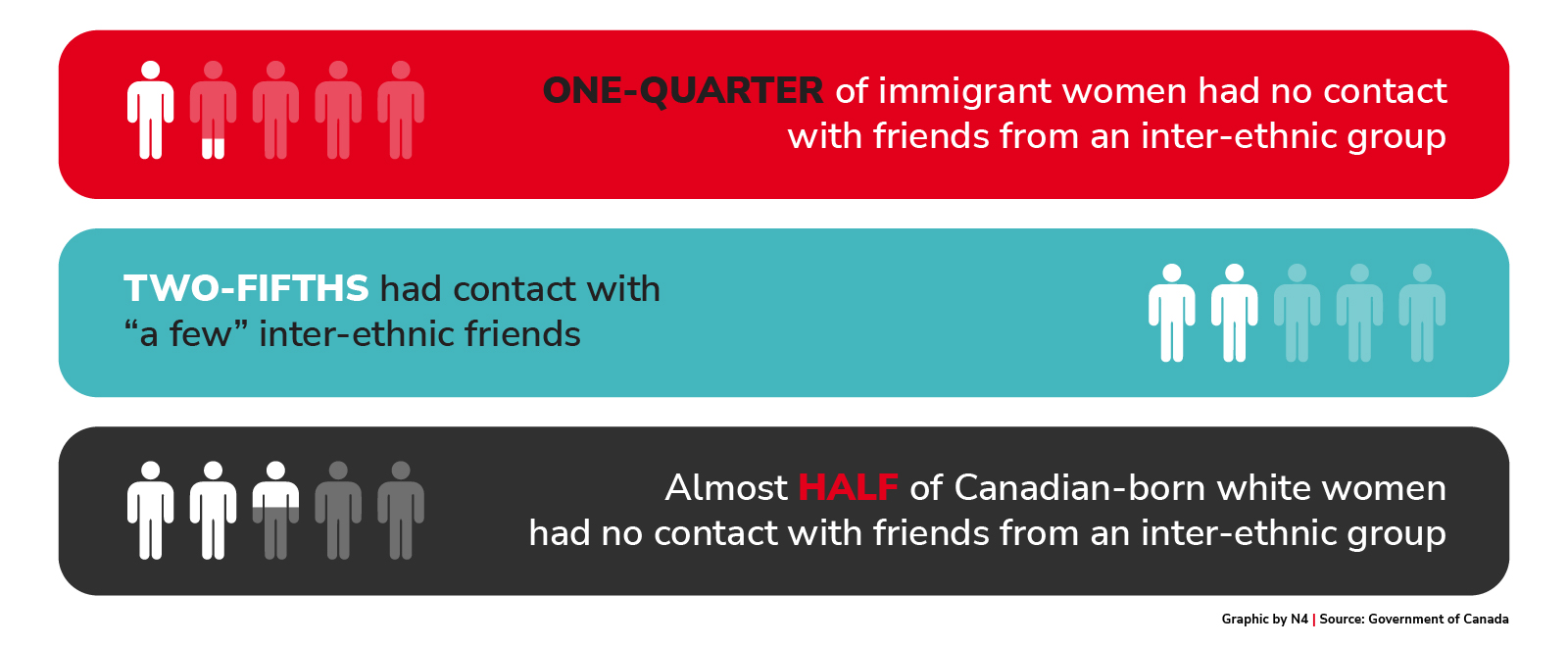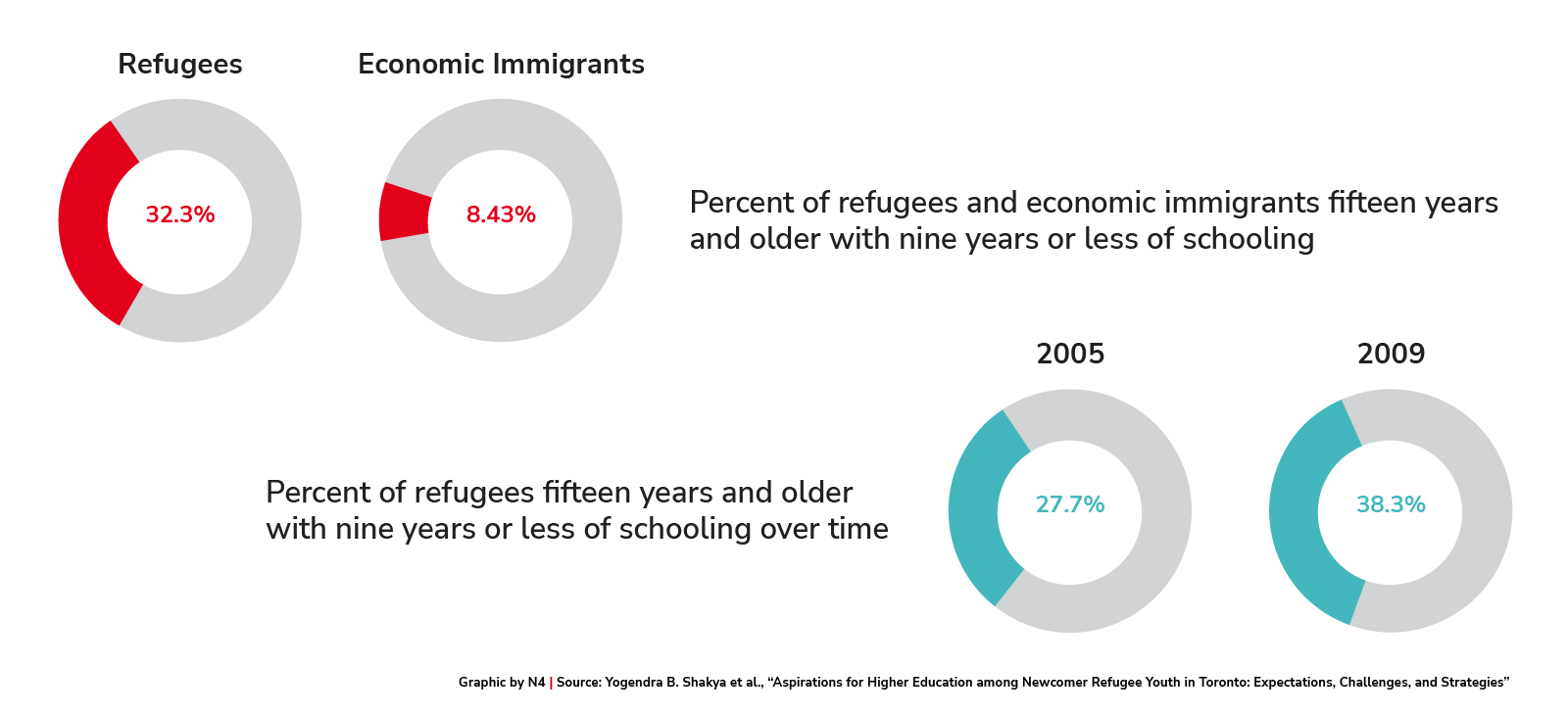Immigrant women have unique experiences in the social, education and labour market contexts. Their ability to participate in higher education and find secure, high-paying jobs can be hindered by many barriers. These charts indicate some trends in the data about immigrant women and indicate potential areas of focus for supporting this population.
Increase in the number of immigrant women identifying as visible minorities in Canada
The social networks of immigrant women2
Statistics Canada has studied the size and qualities of social networks of immigrant women. They found that generally immigrant women had smaller networks of close friends and acquaintances than white Canadian-born women. There were some significant variations based on ethnicity, age and location. In particular, being a refugee and not speaking English or French were traits associated with having a smaller network.
Having a wide and diverse social network is important for immigrant women because it assists with integration and provides avenues for enhanced professional opportunities.
2 Statistics Canada, “The Social Networks of Immigrant Women,” April 24, 2024,
Close friends and acquaintances among immigrant and white Canadian-born women
Educational participation of young refugee women5
Entry into higher education is a significant challenge for young refugee women. Young adult women who entered Canada as refugees underrepresented in higher education in Canada. They face a wide range of barriers to entering and staying in education including language, family obligations, resources and lack of access to appropriate supports.
5 Sonja Aicha van der Putten, “Factors That Influence the Educational Aspirations of Young Adult Women from Refugee Backgrounds,” Centre for Migration Studies, April 3, 2024, https://migration.ubc.ca/working-paper-series/factors-that-influence-the-educational-aspirations-of-young-adult-women-from-refugee-backgrounds/.
Key factors impacting access to higher education

Source: Sonja Aicha van der Putten, “Factors That Influence the Educational Aspirations of Young Adult Women from Refugee Backgrounds,” Centre for Migration Studies, April 3, 2024, https://migration.ubc.ca/working-paper-series/factors-that-influence-the-educational-aspirations-of-young-adult-women-from-refugee-backgrounds/.
Percent of refugees with nine years or less of schooling (2000-2009)
Immigrant women in the Canadian workforce10
Immigrant women are vital contributors to the Canadian workforce. Statistics Canada data from 2022 shows there were 4,200,630 immigrant women in the labour market. However, they are more vulnerable to labour market disruption (such as during COVID-19), tend to earn less, and are over-represented in low-wage sectors.
10 CICNews, “How Are Immigrant Women Faring in Canada’s Workforce? | CIC News,” March 8, 2023, https://www.cicnews.com/2023/03/how-are-immigrant-women-faring-in-canadas-workforce-0333567.html.
Immigrant women in the Canadian labour market in 2022

Source: CICNews, “How Are Immigrant Women Faring in Canada’s Workforce? | CIC News,” March 8, 2023, https://www.cicnews.com/2023/03/how-are-immigrant-women-faring-in-canadas-workforce-0333567.html.
Unemployment gap between recent immigrant and Canadian-born women
Falling median entry wage of racialized newcomer women during COVID-1911

Source: Statistics Canada, “Transitions into and out of Employment by Immigrants during the COVID-19 Lockdown and Recovery,” August 20, 2020, https://www150.statcan.gc.ca/n1/pub/45-28-0001/2020001/article/00070-eng.htm.

Source: “Recent Canadian Immigrants Endured Disproportionate Economic Strain Due to COVID-19: Statistics Canada | CIC News,” December 5, 2022, https://www.cicnews.com/2022/12/recent-canadian-immigrants-endured-disproportionate-economic-strain-due-to-covid-19-statistics-canada-1232184.html.
For further reading on racialized immigrant women in the Canadian labour market, see: Bessma Momani et al, “Knowledge Synthesis Report on Canada’s Racialized Immigrant Women and the Labour Market.” University of Waterloo, 2021.
Suggested Citation: National Newcomer Navigation Network, "Social, Educational, and Economic Participation of Immigrant Women", May 2024, www.newcomernavigation.ca/en/data/social-educational-and-economic-participation-of-immigrant-women.aspx






